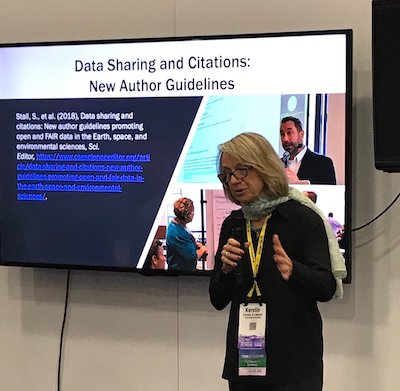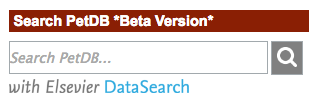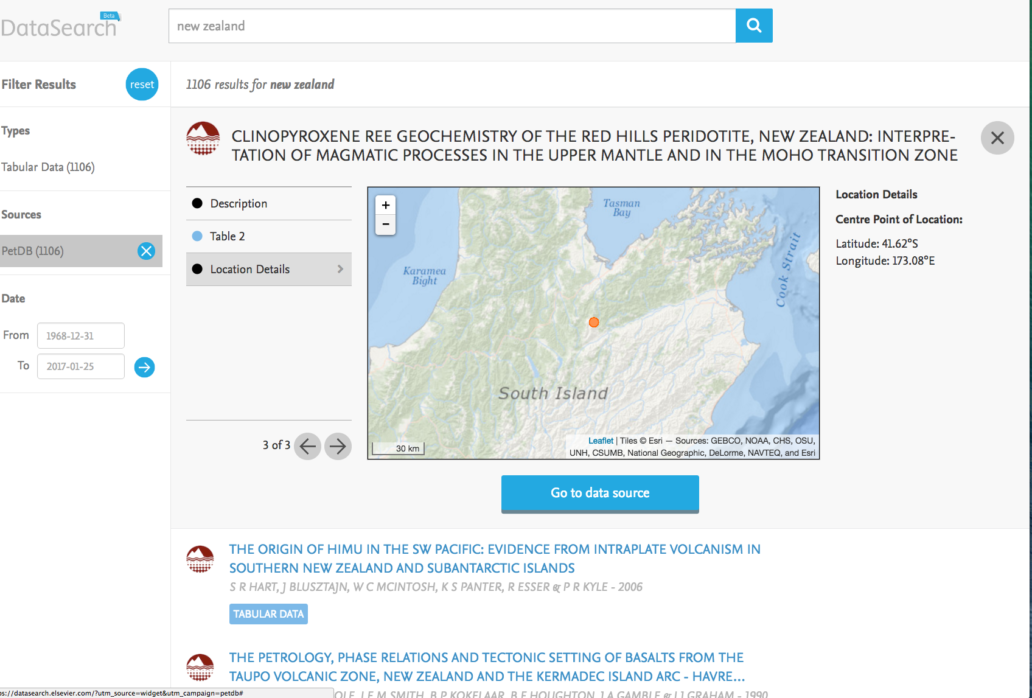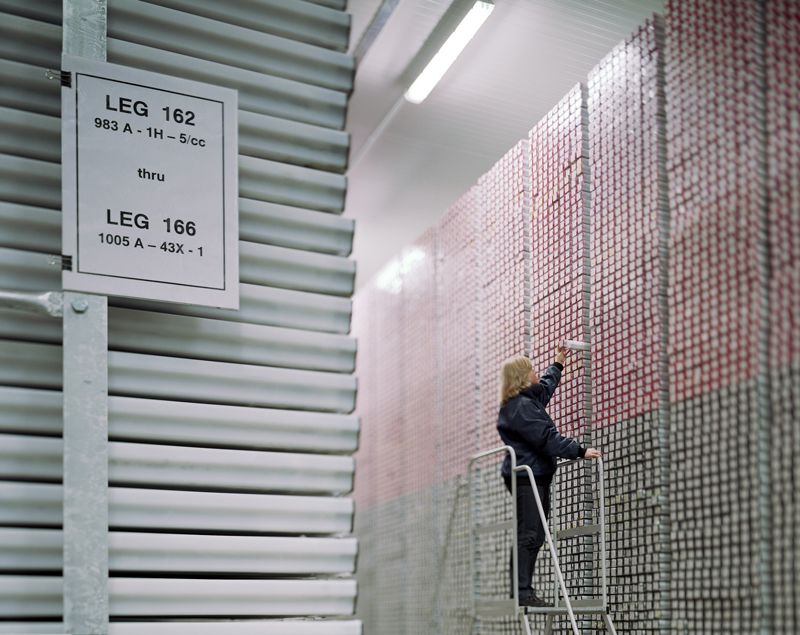EarthChem Newsletter, February 2019
This newsletter summarizes new features and improvements at EarthChem as well as recent community engagement and featured datasets. To subscribe to future quarterly newsletters please click here.
Recent Improvements
- EarthChem Library (ECL) version 3.6.4 was released. This new version allows users to select the Creative Commons license that they would like to associate with their dataset. Users can now choose between four different licenses, providing more flexibility for users to allow reuse for commercial purposes or to make the dataset public domain. See more release notes here.
- The PetDB Search application has been completely redesigned to allow for easier data searching and integration. This new version enhances usability and supports new functionality such as: search by chemical composition; expanded map search, including a southern polar projection; search by age; search by International Geo Sample Number (IGSN); and plotting data as TAS and Harker diagrams. Please write to us at info@petdb.org with any feedback or comments.
Featured Datasets
- Major element data for olivine, orthopyroxene, and spinel within peridotites from the Southwest Indian Ridge. View in the ECL.
- Characterization of plagioclase hosted melt inclusions in A91-1R (Blanco Transform Fault). View in the ECL.
- LA-ICP-MS apatite fission track and U-Pb dataset for southern Baffin Island, Nunavut, Canada. View in the ECL.
- Hadean silicate differentiation preserved by anomalous 142Nd/144Nd ratios in the Reunion hotspot. View in PetDB.
- Extensive young silicic volcanism produces large deep submarine lava flows in the NE Lau Basin. View in PetDB.
- Mantle source heterogeneity for South Tyrrhenian magmas revealed by Pb isotopes & halogen contents of olivine-hosted melt inclusions. View in PetDB.
View the full list of new datasets in the ECL or all datasets in PetDB.
EarthChem Community
The EarthChem Team attended the AGU Fall Meeting held in Washington D.C. See more information below about our presentations at AGU, which included presentations about open and FAIR Data and participation in a Townhall regarding geochemical data standards. If you were not able to catch up with us at AGU, contact us at info@50.16.114.67 with questions or comments about our resources.
- Building a Global Network of Geochemical Data: This Townhall discussed developing geochemical data standards in the Earth Sciences and opportunities for a global geochemical data network. To learn more, please refer to the presentation here.
- Boosting Data Science in Geochemistry: We Need Global Geochemical Data Standards and Networking!: In this presentation, Dr. Lehnert talked about how can we develop global standards that would allow for connecting and exchanging data among the geochemical data systems. The presentation can be found here.

Building a Global Network of Geochemical Data (AGU Town Hall)
Please join us December 11th at AGU for a one hour town hall discussing the development of geochemical data standards and ideas for a global geochemical network.
Future science endeavors in geochemistry, petrology, mineralogy, and volcanology will increasingly rely on access to and analysis of large volumes of data as data science is emerging as a new research paradigm in these fields (see session V017 of the 2018 AGU Fall Meeting). Data systems such as EarthChem and GEOROC have provided access to global, though thematically focused data syntheses. More geochemical data systems are emerging at national, programmatic, and subdomain levels in response to Open Access policies and science needs, and many other data systems and repositories manage geochemical data. There is an urgent need to develop and implement global standards and best practices for geochemical data to become FAIR (Findable, Accessible, Interoperable, Re-usable), and to establish standard protocols for exchanging geochemical data among distributed data systems. This Town Hall aims to engage relevant communities in the Earth sciences in defining and planning steps toward the development of geochemical data standards as well as exploring ideas and opportunities for a global geochemical data network that facilitates and promotes discovery and access of geochemical data through coordination and collaboration among international geochemical data providers. The goal is converge on a common vision for such a global geochemical data network.
December 11, 2018, 6:15-7:15 pm, Marriott Marquis, Room: Independence E
For questions, please contact Kerstin Lehnert (lehnert@ldeo.columbia.edu)
If you were not able to attend the Town Hall, please refer to our slides here.
Data Management Planning Workshop at Goldschmidt 2018
Please join us for a 1-hour IEDA:EarthChem workshop/tutorial on data management planning at the Goldschmidt Conference in Boston.
Workshop Description:
Data management plans (DMP) are now required by federal funding agencies (NSF, NIH, etc.) with all new grant proposals. This workshop, geared toward faculty and researchers, will provide guidance for creating a data management plan and demonstrate online tools that support and facilitate the generation of high-quality DMP and Compliance Reports, including the IEDA DMP Tool, ezDMP, and the IEDA Data Compliance Reporting Tool. Please register for the workshop here.
When? Thursday, August 16, 2018, 1-2PM
Where? Hynes Convention Center, room 108
The workshop is supported by the US National Science Foundation.
For questions, please contact Kerstin Lehnert (lehnert@ldeo.columbia.edu).
EarthChem highlighted in recent Nature call to make all scientific data FAIR
Juan David Figueroa
A recent comment by Stall et al., in Nature urges all scientific disciplines to follow the Geosciences and demand best practices for publishing and data sharing. The comment highlights the efforts of the Geoscience community to elevate the value of data by making it more FAIR (Findable, Accessible, Interoperable, and Reusable). One key example is the shift of many Earth-science journals to no longer listing data in supplementary information, and instead requiring that data be made available in FAIR repositories. In addition to making data easier to re-use, repositories provide “persistent identifiers, curation expertise, landing pages, and support for the citation of data in papers”. Stall et al. specifically highlight EarthChem and its efforts to make data FAIR: “… data sets in the EarthChem Library at the Interdisciplinary Earth Data Alliance are easily found through Google Dataset Search. Data are straightforward to download from a landing page. Data-set formats are aligned with other geochemical, petrological and geochronological data. And they have a long useful life because of their rich metadata on provenance.”
To shift research culture across all scientific disciplines the authors call for three changes: 1) Make depositing open and FAIR data a priority for all, 2) Recognize and incentivize FAIR data practices, 3) Fund global infrastructure to support FAIR data and tools. Click here to read the full Nature comment by Shelley Stall, Lynn Yarmey, Joel Cutcher-Gershenfeld, Brooks Hanson, Kerstin Lehnert, Brian Nosek, Mark Parsons, Erin Robinson & Lesley Wyborn. To learn more about the EarthChem Library or to submit your dataset please click here.
EarthChem Library Webinar: How to Contribute Data
Do you have data from your research that you would like to make accessible online in a trusted repository? Join us for a free webinar on how to deposit your data in the EarthChem Library on Thursday May 31st at 2 pm ET. Register to attend here. If you are able, please also complete this 2 minute survey to help us adapt the webinar to audience interests.
The EarthChem Library (ECL) is an NSF-funded open-access repository for datasets (analytical data, experimental data, synthesis databases) and other digital resources relevant to the fields of geochemistry, geochronology, petrology, and mineralogy. The ECL offers a complete suite of services for data preservation and access, including long-term archiving, registration of data with Digital Object Identifiers (DOIs), and links to publications. The ECL recommends use of data type specific templates that have been developed in collaboration with researchers who work closely with the data types. These templates provide guidance to investigators on the inclusion of key sample and analytical metadata that maximize reusability and discoverability of the datasets. We welcome collaborations to generate templates for new data types.
The ECL has been recognized by funding agencies and publishers as a trusted repository for fulfilling Data Management requirements. To learn more, see www.earthchem.org/library. Please contact us at info@50.16.114.67.
A recording of the webinar can be viewed on our Youtube channel.
Undergraduate Projects Improve Analysis of Geochronological Data
Undergraduate students in the Computer Sciences Department at the College of Charleston are developing open-source software applications and infrastructure aimed at improving access to and analysis of geochronological and other earth-science data. The students are working under the direction of Dr. Jim Bowring at the Cyber Infrastructure Research & Development Lab for the Earth Sciences (CIRDLES). Four of the students recently presented their work at the 2017 Geological Society of America Annual Meeting. Topsoil is highlighted below.
Topsoil: A community driven open source replacement for ISOPLOT
Topsoil is a desktop application and Java library that creates data visualizations for geochronological data. “Topsoil” is an anagram of “Isoplot”, an enormously successful Microsoft Excel Add-In with similar capabilities that now works only in older versions of Excel. Using Topsoil, a user is able to import or manually enter data, which is stored in tables that can be organized and edited by the user. The table is used to create a plot that is freely explorable, and with several built-in plot features that can be toggled on or off, such as uncertainty and concordia line. Plot features are dependent on the isotope system of the given table. Current options are Uranium-Lead or Uranium-Thorium analyses, and more isotope systems will be available to the user in the future.
Advancement of Topsoil depends on the active involvement of the community to guide development and for assistance with design and coding, specification of capabilities, and develpment of help resources. Contributions to Topsoil can be made at https://github.com/cirdles/topsoil.
EarthChem Library Video Tutorials
Multiple EarthChem Library video tutorials have been released on the IEDA YouTube Channel. The videos are aimed at simplifying the data submission process and addressing frequently-asked questions. We plan to continue to grow our video tutorial collection, so please keep an eye on the EarthChem Library YouTube Playlist for more. Tutorials will also be posted at http://50.16.114.67/library/help. If you have questions or suggestions for new tutorials, please contact us at info@50.16.114.67.
- Submit Data to IEDA: How To Get a GeoPass Account
- EarthChem Library Submission Guidelines
- How to Complete an EarthChem Library Data Submission Template
- How to Submit an EarthChem Library Data Submission Template
Elsevier DataSearch Tool Augments Existing PetDB Search
You can now use Elsevier DataSearch to search and browse PetDB data using the search box (pictured below) on the top right-hand corner of the PetDB homepage (www.earthchem.org/petdb). You may use free text to search. Elsevier DataSearch allows you to preview datasets within PetDB and then, if you wish, allows you to proceed to that dataset in PetDB.
The primary goal of the Elsevier DataSearch Tool is to help investigators “find research data across domains and types, from many domain-specific, cross-domain and institutional data repositories.” Learn more and search for datasets and publications across repositories, including PetDB, here. Test it out and let us know what you think at info@petdb.org.





